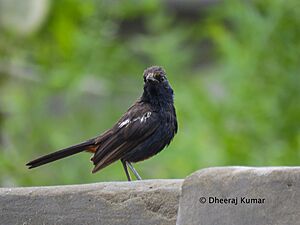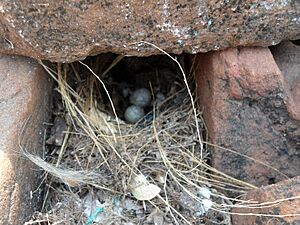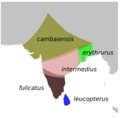Indian robin facts for kids
Quick facts for kids Indian robin |
|
|---|---|
 |
|
| Male of the subspecies cambaiensis (Kanha National Park, Madhya Pradesh, India) |
|
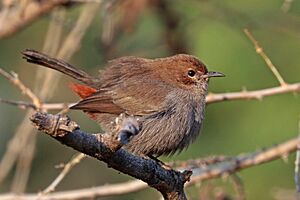 |
|
| Female of the subspecies cambaiensis (Rajasthan) |
|
| Conservation status | |
| Scientific classification | |
| Genus: |
Copsychus
|
| Species: |
fulicatus
|
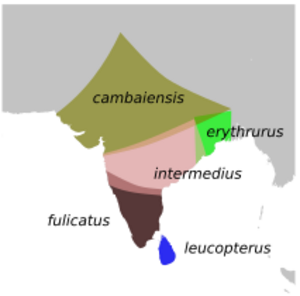 |
|
| Synonyms | |
|
|
The Indian robin (Copsychus fulicatus) is a small bird that belongs to the Muscicapidae family, which includes flycatchers and chats. These birds are common in the Indian subcontinent, living in countries like Bangladesh, Bhutan, India, Nepal, Pakistan, and Sri Lanka.
Male Indian robins from the northern parts of their range have brown backs. As you go further south, the brown on their backs gets smaller, and males in the very south have all-black backs. You can often spot them in open, bushy areas. They like to run along the ground or sit on low thorny bushes and rocks. Their long tails are usually held straight up. The bright chestnut color under their tails and their dark bodies make them easy to tell apart from other similar birds.
Contents
About the Indian Robin's Name
The Indian robin got its scientific name, Motacilla fulicata, from a famous Swedish scientist named Carl Linnaeus in 1766. The word fulicatus comes from Latin and means "dusky" or "black," which describes the bird's dark feathers.
For a long time, the Indian robin was placed in its own unique group called Saxicoloides. But after scientists did more studies using DNA (molecular phylogenetic studies), they found that the Indian robin was actually more closely related to birds in the Copsychus group. So, it was moved there.
What Does the Indian Robin Look Like?
Indian robins look different depending on if they are male or female. This is called being sexually dimorphic.
- Males are mostly black. They have a white patch or stripe on their shoulder that can look bigger or smaller depending on how they stand. Their upper feathers can be brownish in northern areas, but they are black in southern areas. Males also have bright chestnut-colored feathers under their tails. They usually hold their 6–8 cm long tail straight up, making these colorful feathers easy to see.
- Females are brownish on top. They don't have the white shoulder stripe. Their undersides are greyish, with a paler chestnut color under their tails compared to the males.
- Young birds look a lot like females, but their throats might have a mottled or spotty pattern.
Birds from northern India are generally bigger than those from southern India or Sri Lanka. There are also different types, called subspecies, based on small differences in their feathers and where they live. For example, the cambaiensis type lives in northern India, and the leucopterus type lives in Sri Lanka.
People in different parts of India have given the Indian robin local names. Some of these include Nalanchi (Telugu), Wannatikuruvi (Tamil, meaning "Washerman bird"), Dayaal (Marathi), Kalchuri (Hindi), and Paan kiriththaa (Sinhala).
Where Do Indian Robins Live?
Indian robins like open areas with rocks, grass, and scattered bushes or small trees. They prefer dry places and usually stay away from thick forests or areas with a lot of rain. These birds do not migrate; they stay in the same area all year round. You can often find them near towns and villages, sometimes even perching on rooftops.
Indian Robin Behavior and Diet
Indian robins are quite common. In some areas, scientists have counted many birds living close together. Males can be quite protective of their space during the breeding season. They might even attack their own reflection in a window! Interestingly, some human activities like cutting down trees for firewood in forests can actually help these birds by creating more open spaces for them.
What Do Indian Robins Eat?
Indian robins mainly eat insects. But they are also known to catch small frogs and lizards, especially when they are feeding their young ones in the nest. Sometimes, you might see them hunting for insects late in the evening, catching bugs that are attracted to lights.
Indian Robin Reproduction and Life Cycle
The breeding season for Indian robins can last from December to September, but it changes depending on the region. It usually starts when the first rains arrive. In northern India, they breed most actively in June, while in southern India, it's earlier.
During this time, male robins sing to attract mates and warn other males to stay away. They also perform a special dance for the female, lowering and spreading their tail feathers and puffing up the feathers under their tails. Males will chase away other males and fly slowly from perch to perch to guard their territory.
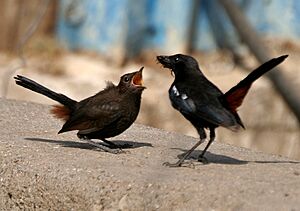
Indian robins build their nests in safe spots, like between rocks, inside holes in walls, or in tree hollows. They line their nests with animal hair and sometimes even pieces of snakeskin!
The eggs are usually oval-shaped, about 2 cm long and 1.5 cm wide. They are white, sometimes with a faint green or pink tint, and covered with reddish-brown or yellowish-brown spots and streaks. These markings are usually thicker at the wider end of the egg. A female robin usually lays three to four eggs.
Only the female bird sits on the eggs to keep them warm, which is called incubation. The eggs hatch in about 10 to 12 days. The baby chicks are born with black fuzzy feathers. Both the male and female parents work together to feed the young birds. Sometimes, the male will give food to the female, and she will then feed the chicks. If a nestling feels threatened, it might pretend to be dead to avoid danger! The same nest site might be used again in the following years.
Images for kids
-
Male of the subspecies cambaiensis
(Kanha National Park, Madhya Pradesh, India) -
Female of the subspecies cambaiensis
(Rajasthan)




